Study on Correlation between Structural and Electronic Properties of Fluorinated Oligothiophenes Transistors by Controlling Film Thickness
Abstract
:1. Introduction
2. Transistor Characterization
3. Structural Property Characterization
4. Temperature Dependent Transport Measurement and Analysis
5. Morphological Effect on Charge Injection
6. Conclusions
Supplementary Materials
Author Contributions
Funding
Conflicts of Interest
References
- Usta, H.; Facchetti, A.; Marks, T.J. n-Channel semiconductor materials design for organic complementary circuits. Acc. Chem. Res. 2011, 44, 501–510. [Google Scholar] [CrossRef]
- Muccini, M. A bright future for organic field-effect transistors. Nat. Mater. 2006, 5, 605–613. [Google Scholar] [CrossRef]
- Usta, H.; Sheets, W.C.; Denti, M.; Generali, G.; Capelli, R.; Lu, S.; Yu, X.; Muccini, M.; Facchetti, A. Perfluoroalkyl-functionalized thiazole–thiophene oligomers as n-channel semiconductors in organic field-effect and light-emitting transistors. Chem. Mater. 2014, 26, 6542–6556. [Google Scholar] [CrossRef]
- de Zerio Mendaza, A.D.; Melianas, A.; Rossbauer, S.; Bӓcke, O.; Nordstierna, L.; Erhart, P.; Olsson, E.; Anthopoulos, T.D.; Inganӓs, O.; Müller, C. High-entropy mixtures of pristine fullerenes for solution-processed transistors and solar cells. Adv. Mater. 2015, 27, 7325–7331. [Google Scholar] [CrossRef]
- Zhao, X.; Liu, T.; Cui, Y.; Hou, X.; Liu, Z.; Dai, X.; Kong, J.; Shi, W.; Dennis, T.J.S. Antisolvent-assisted controllable growth of fullerene single crystal microwires for organic field effect transistors and photodetectors. Nanoscale 2018, 10, 8170–8179. [Google Scholar] [CrossRef] [PubMed]
- Zhang, F.; Hu, Y.; Schuettfort, T.; Di, C.-A.; Gao, X.; McNeill, C.R.; Thomsen, L.; Mannsfeld, S.C.B.; Yuan, W.; Sirringhaus, H.; et al. Critical role of alkyl chain branching of organic semiconductors in enabling solution-processed n-channel organic thin-film transistors with mobility of up to 3.50 cm2 V−1 s−1. J. Am. Chem. Soc. 2013, 135, 2338–2349. [Google Scholar] [CrossRef] [PubMed]
- Welford, A.; Maniam, S.; Gann, E.; Thomsen, L.; Langford, S.J.; McNeill, C.R. Thionation of naphthalene diimide molecules: Thin-film microstructure and transistor performance. Org. Electron. 2018, 53, 287–295. [Google Scholar] [CrossRef]
- Tilley, A.J.; Guo, C.; Miltenburg, M.B.; Schon, T.B.; Yan, H.; Li, Y.; Seferos, D.S. Thionation enhances the electron mobility of perylene diimide for high performance n-channel organic field effect transistors. Adv. Funct. Mater. 2015, 25, 3321–3329. [Google Scholar] [CrossRef]
- Xu, X.; Yao, Y.; Shan, B.; Gu, X.; Liu, D.; Liu, J.; Xu, J.; Zhao, N.; Hu, W.; Miao, Q. Electron mobility exceeding 10 cm2 V−1 s−1 and band-like charge transport in solution-processed n-channel organic thin-film transistors. Adv. Mater. 2016, 28, 5276–5283. [Google Scholar] [CrossRef] [PubMed]
- Wu, Q.; Ren, S.; Wang, M.; Qiao, X.; Li, H.; Gao, X.; Yang, X.; Zhu, D. Alkyl chain orientations in dicyanomethylene-substituted 2,5-di(thiophen-2-yl)thieno-[3,2-b]thienoquinoid: Impact on solid-state and thin-film transistor performance. Adv. Funct. Mater. 2013, 23, 2277–2284. [Google Scholar] [CrossRef]
- Facchetti, A.; Mushrush, M.; Katz, H.E.; Marks, T.J. n-Type building blocks for organic electronics: A homologous family of fluorocarbon-substituted thiophene oligomers with high carrier mobility. Adv. Mater. 2003, 15, 33–38. [Google Scholar] [CrossRef]
- Facchetti, A.; Mushrush, M.; Yoon, M.-H.; Hutchison, G.R.; Ratner, M.A.; Marks, T.J. Building blocks for n-type molecular and polymeric electronics. Perfluoroalkyl-versus alkyl-functionalized oligothiophenes (nT; n = 2–6). Systematics of thin film microstructure, semiconductor performance, and modeling of majority charge injection in field-effect transistors. J. Am. Chem. Soc. 2004, 126, 13859–13874. [Google Scholar]
- Yoon, M.-H.; Kim, C.; Facchetti, A.; Marks, T.J. Gate dielectric chemical structure−organic field-effect transistor performance correlations for electron, hole, and ambipolar organic semiconductors. J. Am. Chem. Soc. 2006, 128, 12851–12869. [Google Scholar] [CrossRef] [PubMed]
- Capelli, R.; Toffanin, S.; Generali, G.; Usta, H.; Facchetti, A.; Muccini, M. Organic light-emitting transistors with an efficiency that outperforms the equivalent light-emitting diodes. Nat. Mater. 2010, 9, 496–503. [Google Scholar] [CrossRef] [PubMed]
- Chang, J.-F.; Chen, W.-R.; Lai, Y.-C.; Chien, F.-C. Red phosphorescent trilayer organic light-emitting field-effect transistors with a wide recombination zone. Jpn. J. Appl. Phys. 2016, 55, 020304. [Google Scholar] [CrossRef]
- Chang, J.-F.; Chen, W.-R.; Huang, S.-M.; Lai, Y.-C.; Lai, X.-Y.; Yang, Y.-W.; Wang, C.-H. High mobility ambipolar organic field-effect transistors with a nonplanar heterojunction structure. Org. Electron. 2015, 27, 84–91. [Google Scholar] [CrossRef]
- Dholakia, G.R.; Meyyappan, M.; Facchetti, A.; Marks, T.J. Monolayer to multilayer nanostructural growth transition in n-type oligothiophenes on Au(111) and implications for organic field-effect transistor performance. Nano Lett. 2006, 6, 2447–2455. [Google Scholar] [CrossRef]
- Facchetti, A.; Yoon, M.-H.; Stern, C.L.; Hutchison, G.R.; Ratner, M.A.; Marks, T.J. Building blocks for n-type molecular and polymeric electronics. Perfluoroalkyl- versus alkyl-functionalized oligothiophenes (nTs; n = 2–6). Systematic synthesis, spectroscopy, electrochemistry, and solid-state organization. J. Am. Chem. Soc. 2004, 126, 13480–13501. [Google Scholar] [CrossRef]
- DeLongchamp, D.M.; Kline, R.J.; Lin, E.K.; Fischer, D.A.; Richter, R.J.; Lucas, L.A.; Heeney, M.; McCulloch, I.; Northrup, J.E. High carrier mobility polythiophene thin films: Structure determination by experiment and theory. Adv. Mater. 2007, 19, 833–837. [Google Scholar] [CrossRef]
- Lue, J.-W.; Lin, Y.-H.; Yang, Y.-W. Growth and electronic structure studies of semiconducting thin films of fluorine-monosubstituted fused-thiophene derivative. J. Electron Spectrosc. Relat. Phenom. 2014, 196, 49–53. [Google Scholar] [CrossRef]
- Dhez, O.; Ade, H.; Urquhart, S.G. Calibrated NEXAFS spectra of some common polymers. J. Electron Spectrosc. Relat. Phenom. 2003, 128, 85–96. [Google Scholar] [CrossRef]
- Zharnikov, M.; Frey, S.; Heister, K.; Grunze, M. An extension of the mean free path approach to X-ray absorption spectroscopy. J. Electron Spectrosc. Relat. Phenom. 2002, 124, 15–24. [Google Scholar] [CrossRef]
- Ohta, T.; Seki, K.; Yokoyama, T.; Morisada, I.; Edamatsu, K. Polarized XANES studies of oriented polyethylene and fluorinated polyethylenes. Phys. Scr. 1990, 41, 150–153. [Google Scholar] [CrossRef]
- Väterlein, P.V.; Fink, R.; Umbach, E.; Wurth, W. Analysis of the x-ray absorption spectra of linear saturated hydrocarbons using the Xα scattered-wave method. J. Chem. Phys. 1998, 108, 3313–3320. [Google Scholar] [CrossRef]
- Stöhr, J. NEXAFS Spectroscopy; Springer: Berlin, Germany, 1992. [Google Scholar]
- Wang, C.-H.; Cheng, Y.-C.; Su, J.-W.; Fan, L.-J.; Huang, P.-Y.; Chen, M.-C.; Yang, Y.-W. Origin of high field-effect mobility in solvent-vapor annealed anthradithiophene derivative. Org. Electron. 2010, 11, 1947–1953. [Google Scholar] [CrossRef]
- Brown, A.R.; Jarrett, C.P.; deLeeuw, D.M.; Matters, M. Field-effect transistors made from solution-processed organic semiconductors. Synth. Met. 1997, 88, 37–55. [Google Scholar] [CrossRef]
- Street, R.A.; Northrup, J.E.; Salleo, A. Transport in polycrystalline polymer thin-film transistors. Phys. Rev. B 2005, 71, 165202. [Google Scholar] [CrossRef]
- Salleo, A.; Chen, T.W.; Völkel, A.R.; Wu, Y.; Liu, P.; Ong, B.S.; Street, R.A. Intrinsic hole mobility and trapping in a regioregular poly(thiophene). Phys. Rev. B 2004, 70, 115311. [Google Scholar] [CrossRef]
- Street, R.A. Hydrogenated Amorphous Silicon; Cambridge University Press: Cambridge, UK, 1991. [Google Scholar]
- Chang, J.-F.; Sirringhaus, H.; Giles, M.; Heeney, M.; McCulloch, I. Relative importance of polaron activation and disorder on charge transport in high-mobility conjugated polymer field-effect transistors. Phys. Rev. B 2007, 76, 205204. [Google Scholar] [CrossRef]
- Shi, J.; Wang, H.; Song, D.; Tian, H.; Geng, Y.; Yan, D. n-Channel, ambipolar, and p-channel organic heterojunction transistors fabricated with various film morphologies. Adv. Funct. Mater. 2007, 17, 397–400. [Google Scholar] [CrossRef]
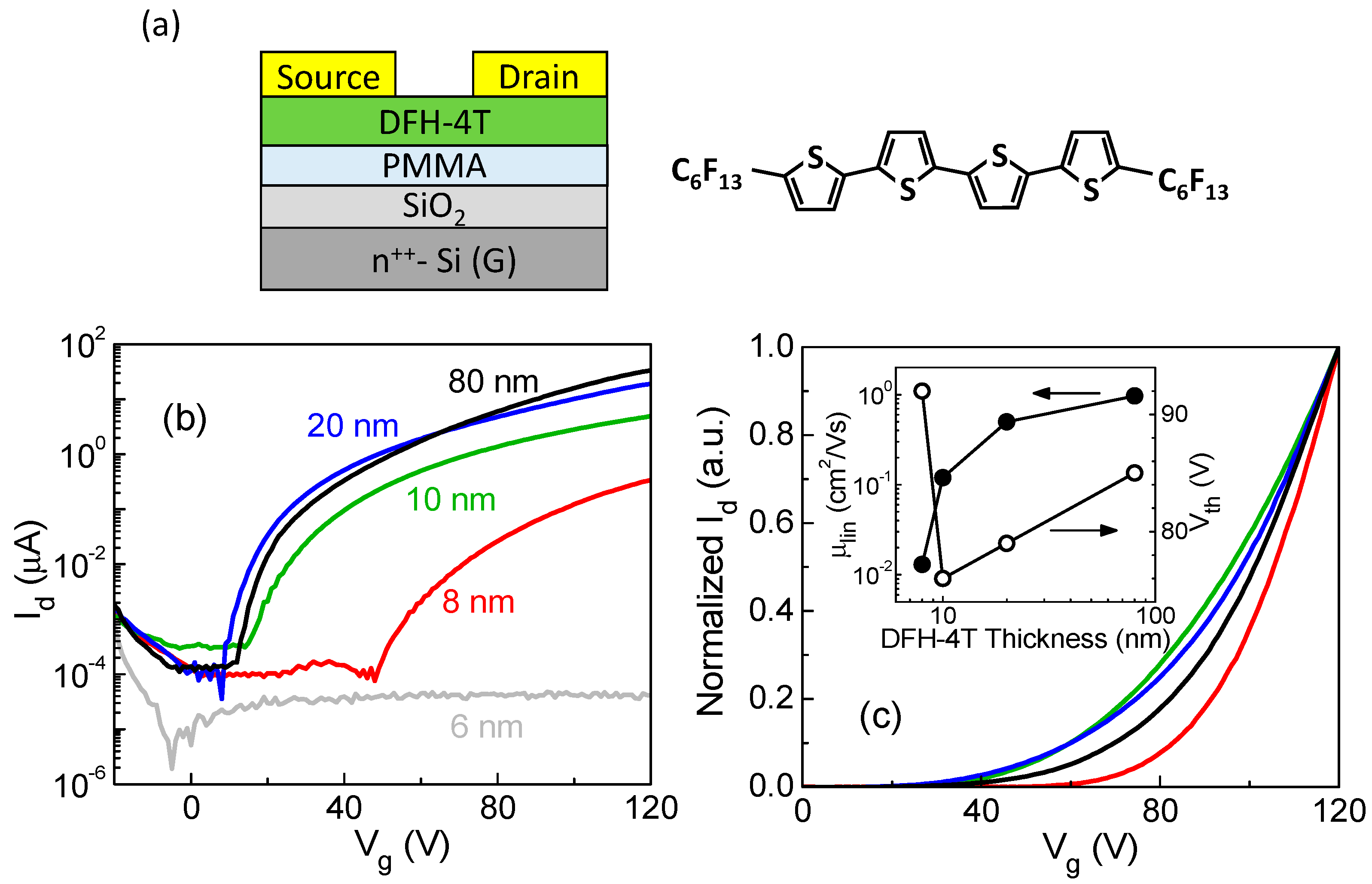
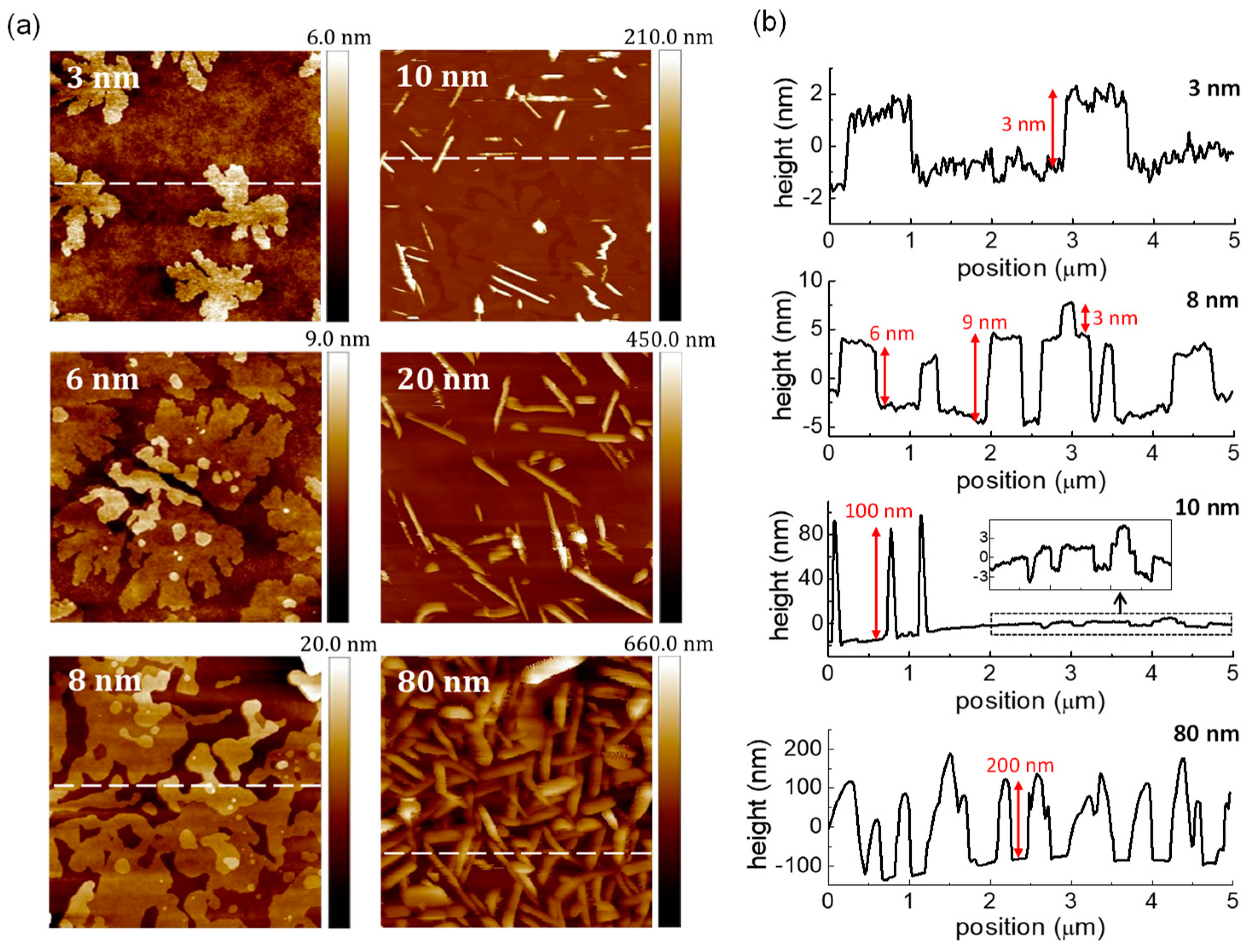
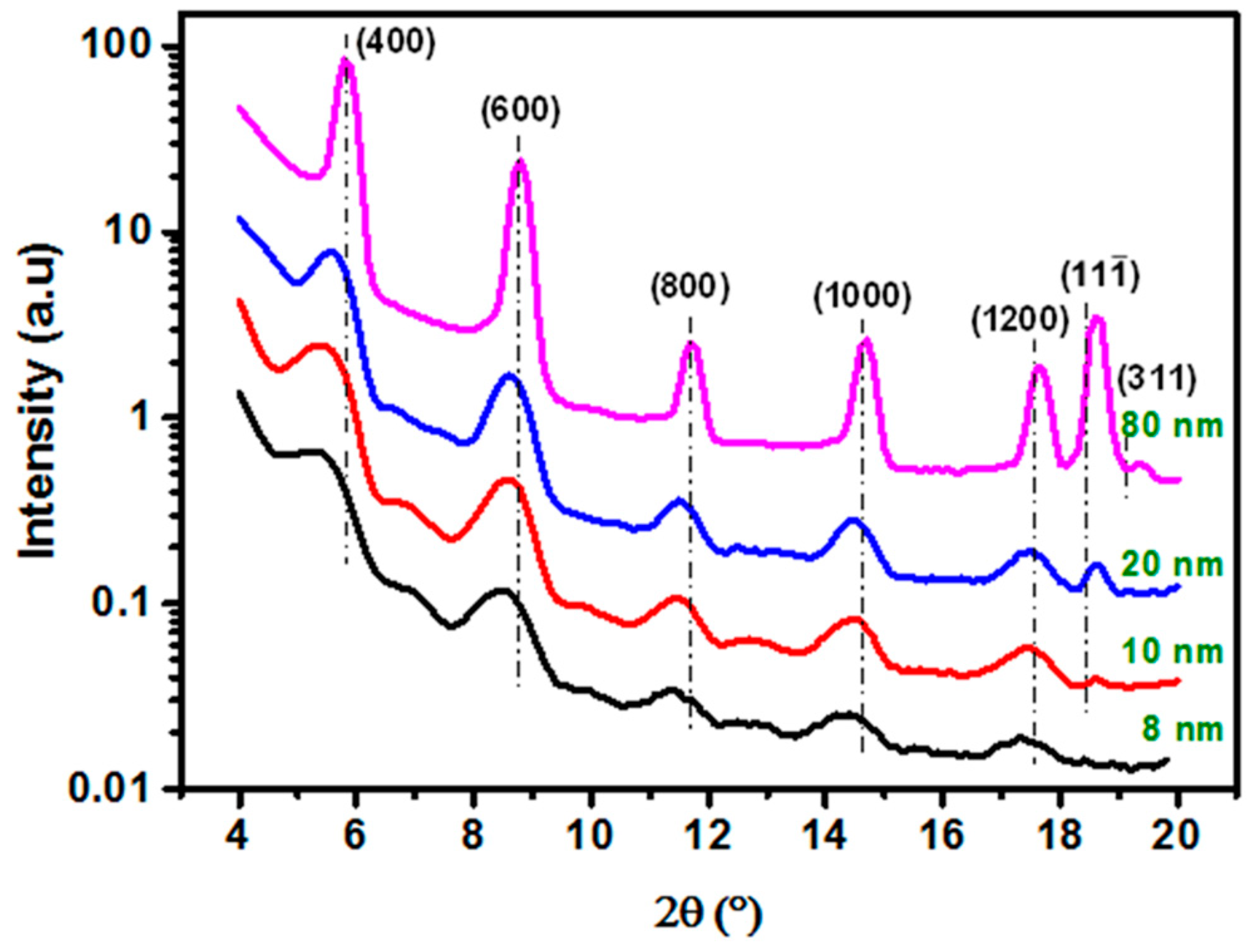
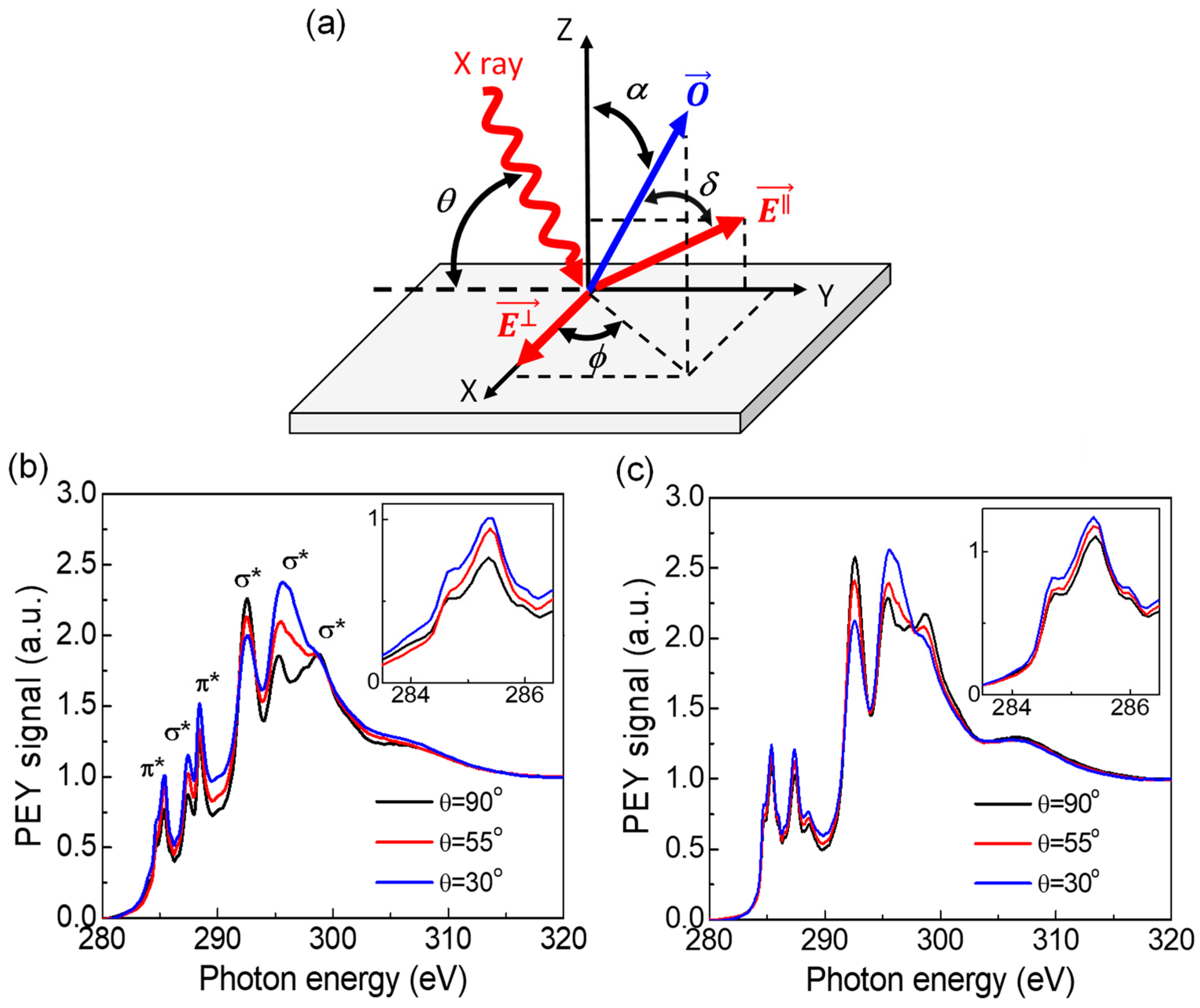
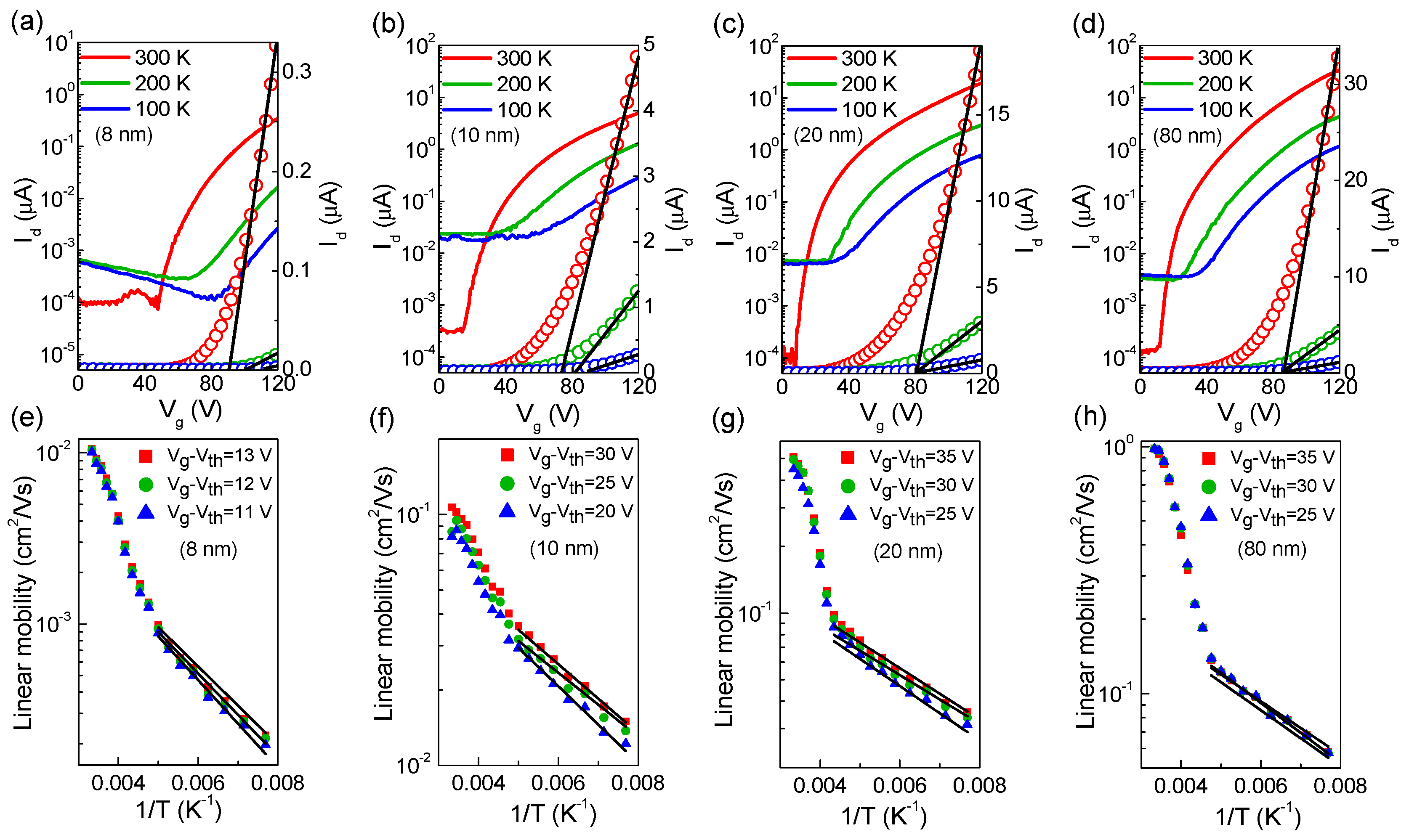
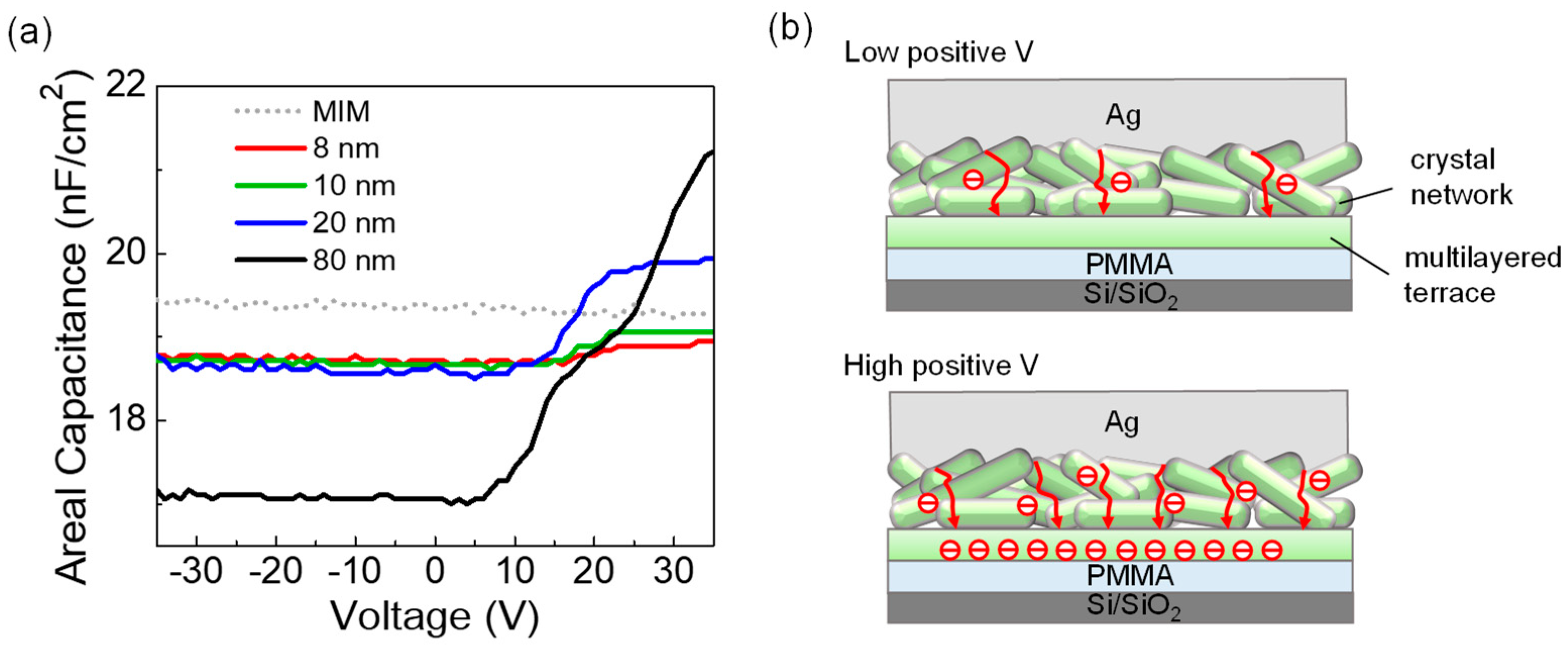
| Thickness (nm) | μi (cm2·V−1·s−1) | wtail (meV) | Ntail (cm−3) |
|---|---|---|---|
| 8 | 0.0063 | 20 | 5.3 × 1019 |
| 10 | 0.11 | 16 | 4.8 × 1019 |
| 20 | 0.207 | 14.8 | 4.7 × 1019 |
| 80 | 0.34 | 14.3 | 4.3 × 1019 |
© 2019 by the authors. Licensee MDPI, Basel, Switzerland. This article is an open access article distributed under the terms and conditions of the Creative Commons Attribution (CC BY) license (http://creativecommons.org/licenses/by/4.0/).
Share and Cite
Chang, J.-F.; Shie, H.-S.; Yang, Y.-W.; Wang, C.-H. Study on Correlation between Structural and Electronic Properties of Fluorinated Oligothiophenes Transistors by Controlling Film Thickness. Crystals 2019, 9, 144. https://doi.org/10.3390/cryst9030144
Chang J-F, Shie H-S, Yang Y-W, Wang C-H. Study on Correlation between Structural and Electronic Properties of Fluorinated Oligothiophenes Transistors by Controlling Film Thickness. Crystals. 2019; 9(3):144. https://doi.org/10.3390/cryst9030144
Chicago/Turabian StyleChang, Jui-Fen, Hua-Shiuan Shie, Yaw-Wen Yang, and Chia-Hsin Wang. 2019. "Study on Correlation between Structural and Electronic Properties of Fluorinated Oligothiophenes Transistors by Controlling Film Thickness" Crystals 9, no. 3: 144. https://doi.org/10.3390/cryst9030144
APA StyleChang, J.-F., Shie, H.-S., Yang, Y.-W., & Wang, C.-H. (2019). Study on Correlation between Structural and Electronic Properties of Fluorinated Oligothiophenes Transistors by Controlling Film Thickness. Crystals, 9(3), 144. https://doi.org/10.3390/cryst9030144





